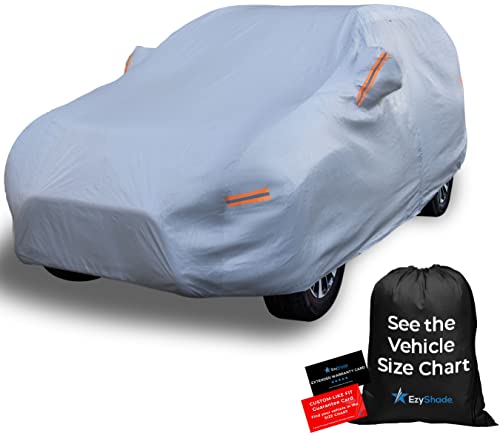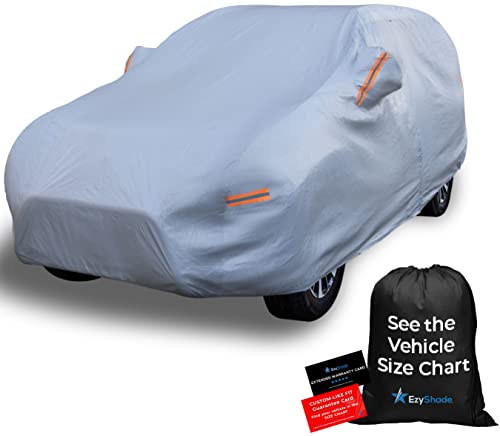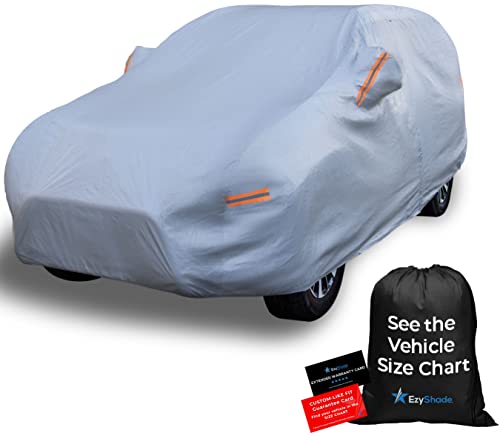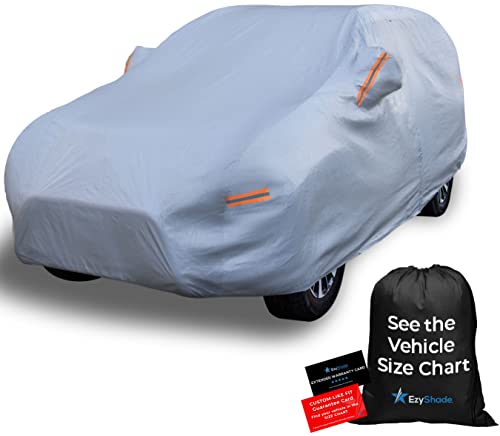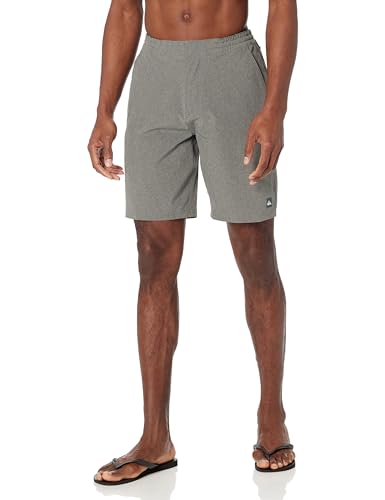Planning a family road trip across the country? Or maybe you need a vehicle that can handle both city commutes and weekend adventures? Finding the best full size SUV 2025 can feel overwhelming, but it doesn’t have to be. This guide will help you navigate the options, understand key features, and ultimately choose the perfect vehicle for your needs. You’ll gain valuable insights into different models, safety features, fuel efficiency, and more, saving you time and making the car-buying process smoother. This article will break down everything you need to know about finding the best full size SUV 2025.
Key Takeaways
- Discover top-rated full-size SUVs for 2025.
- Compare features, safety ratings, and fuel economy across models.
- Learn about the pros and cons of different full-size SUV options.
- Understand factors to consider when choosing a full-size SUV.
- Make an informed decision to buy the best full-size SUV for your needs.
Top Contenders for Best Full-Size SUV 2025
This section explores some of the leading contenders for the title of best full-size SUV in 2025. We’ll examine their strengths and weaknesses, focusing on factors like passenger space, cargo capacity, fuel efficiency, and safety features. We’ll also look at pricing and overall value to help you make an informed decision.
Chevrolet Suburban
The Suburban is known for its legendary space and towing capacity. It consistently ranks highly in consumer satisfaction surveys. Its strong engine options provide ample power for both city driving and off-road adventures. A redesigned interior for 2025 offers improved comfort and technology.
- Spacious interior: Offers three rows of seating with ample legroom and headroom for passengers of all sizes.
- Powerful engine options: Provides various engine choices, ensuring sufficient power for towing and hauling.
- Impressive towing capacity: Can tow significant weight, making it ideal for boat owners and those who frequently haul large items.
Ford Expedition
The Ford Expedition offers a rugged exterior design paired with a comfortable and refined interior. Its advanced driver-assistance systems improve safety while the updated infotainment system provides a seamless user experience. It’s a popular choice for families and adventurers alike.
- Robust build quality: Known for its durability and ability to withstand tough conditions.
- Advanced technology features: Includes a range of driver-assistance features and an intuitive infotainment system.
- Excellent off-road capabilities: Available in a variety of trims, some of which are specifically designed for off-road adventures.
Toyota Sequoia
Toyota’s Sequoia, known for its reliability and longevity, competes strongly in the full-size SUV market. The 2025 model boasts updated styling, a more powerful engine, and improved fuel efficiency compared to previous generations. Toyota’s reputation for reliability remains a key selling point.
- Exceptional reliability: Toyota’s reputation for reliability makes the Sequoia a long-term investment.
- Fuel efficiency improvements: The 2025 model boasts better fuel economy than its predecessors.
- Advanced safety features: Comes standard with a comprehensive suite of safety features.
Choosing the Right Full-Size SUV for Your Lifestyle
Selecting the best full size SUV 2025 isn’t just about specs; it’s about aligning the vehicle’s capabilities with your lifestyle. This section will delve deeper into crucial factors to consider for making the best choice, ensuring you get a perfect fit.
Factors to Consider
- Passenger capacity and cargo space: Consider the number of passengers you regularly transport and your cargo needs. A large family will need more seating and cargo space than a couple.
- Fuel efficiency: Compare the EPA estimates for different models and consider your typical driving habits. If you drive long distances frequently, fuel efficiency is a crucial factor.
- Safety features: Prioritize vehicles with advanced safety features such as automatic emergency braking, lane-keeping assist, and adaptive cruise control.
- Towing capacity: If you plan to tow a boat, trailer, or other heavy loads, ensure the SUV has sufficient towing capacity.
Step-by-Step Guide to Choosing Your SUV
- Assess your needs: Determine your passenger capacity, cargo space, and towing requirements.
- Research models: Explore different full-size SUVs that meet your needs, reading reviews and comparing specifications.
- Compare prices: Get quotes from multiple dealerships to find the best price for your chosen model.
- Test drive: Test drive your top choices to get a feel for their handling, comfort, and features.
- Make your decision: Consider all factors and choose the SUV that best suits your lifestyle and budget.
Comparative Analysis of Top Full-Size SUVs
This section directly compares some of the leading full-size SUVs using a tabular format. This allows for an easy side-by-side review of key specifications, aiding in informed decision-making. Remember, options and pricing can vary by trim levels and location.
| Feature | Chevrolet Suburban | Ford Expedition | Toyota Sequoia |
|---|---|---|---|
| Starting Price (Estimate) | $55,000 | $53,000 | $58,000 |
| Passenger Capacity | 9 | 8 | 8 |
| Cargo Space (behind 3rd row) | 41.5 cu ft | 20 cu ft | 28.9 cu ft |
| Towing Capacity (Max) | 8300 lbs | 9300 lbs | 9000 lbs |
| Fuel Economy (EPA est. combined, MPG) | 18 | 17 | 19 |
Note: These are estimated figures and may vary based on trim level and configuration. Consult official manufacturer specifications for precise details.
Debunking Common Myths about Full-Size SUVs
Several misconceptions surround full-size SUVs. This section clarifies these myths, providing you with accurate information to make better-informed decisions.
Myth 1: Full-size SUVs are always gas guzzlers.
While some full-size SUVs have low fuel economy, many models offer improved fuel efficiency through advancements in engine technology and hybrid options. Many manufacturers are focusing on better fuel efficiency without sacrificing power.
Myth 2: All full-size SUVs are difficult to maneuver in city driving.
While larger than compact SUVs, advancements in technology, such as parking assist and improved visibility features, make navigating city streets more manageable. Modern features compensate for size challenges.
Myth 3: Full-size SUVs are only for large families.
While ideal for large families, full-size SUVs also appeal to individuals and couples seeking maximum space and versatility for cargo, towing, or long road trips. Space and functionality are not solely limited to family use.
Real-Life Case Studies and Scenarios
To illustrate the practical application of choosing the right full-size SUV, here are a couple of real-life scenarios.
Case Study 1: The Active Family
The Peterson family, with three children and a love for outdoor activities, opted for the Ford Expedition. Its robust build, large cargo space, and towing capacity perfectly supported their active lifestyle, allowing them to comfortably transport equipment and tow their boat.
Case Study 2: The Cross-Country Travelers
The Smiths, a couple planning a cross-country road trip, chose the Toyota Sequoia for its reliability and comfortable seating. The fuel efficiency improvements in the 2025 model reduced their fuel costs considerably during their extensive journey.
Scenario 1: Choosing between a Suburban and an Expedition.
If you prioritize maximum towing capacity, the Expedition might be better. But if passenger space is paramount and a smooth, comfortable ride is preferred, the Suburban might be more suitable.
Frequently Asked Questions (FAQs)
What are the best safety features to look for in a full-size SUV?
Look for features like automatic emergency braking (AEB), lane departure warning (LDW), adaptive cruise control (ACC), blind-spot monitoring (BSM), and rear cross-traffic alert (RCTA). These features can significantly improve your safety on the road. Some models may also offer advanced driver assistance systems, such as lane-keeping assist and automatic high-beam headlights.
How do I compare fuel economy across different full-size SUVs?
The EPA provides fuel economy estimates for each vehicle, allowing you to compare city, highway, and combined MPG. Keep in mind that actual fuel efficiency may vary depending on driving habits and conditions. You can often find this information on the manufacturer’s website or at fueleconomy.gov.
What is the typical cost of maintenance for a full-size SUV?
Maintenance costs vary based on the make and model of the SUV, as well as your driving habits. However, it’s generally higher than for smaller vehicles due to larger parts and higher service costs. It’s prudent to budget for higher maintenance expenses compared to smaller vehicles.
What are the pros and cons of buying a used vs. new full-size SUV?
Buying a used full-size SUV can save you money upfront, but it might come with higher repair costs down the line. A new SUV will have a warranty, but it carries a higher initial purchase price. Consider your budget and risk tolerance when making this decision.
What are some of the latest technological advancements in full-size SUVs?
Recent advancements include improved infotainment systems with larger touchscreens, smartphone integration, advanced driver-assistance systems (ADAS), and improved safety features. Many models also offer wireless charging and advanced connectivity options.
Final Thoughts
Choosing the best full size SUV 2025 is a significant decision, impacted by your specific lifestyle and needs. By carefully considering factors like passenger capacity, cargo space, fuel efficiency, safety, and towing capacity, you can narrow down your options and identify the perfect vehicle. Remember to test drive your top contenders and compare prices from different dealerships before committing to a purchase. Don’t hesitate to consult professional reviews and utilize online resources to gather further information before making your final choice. Happy driving!

